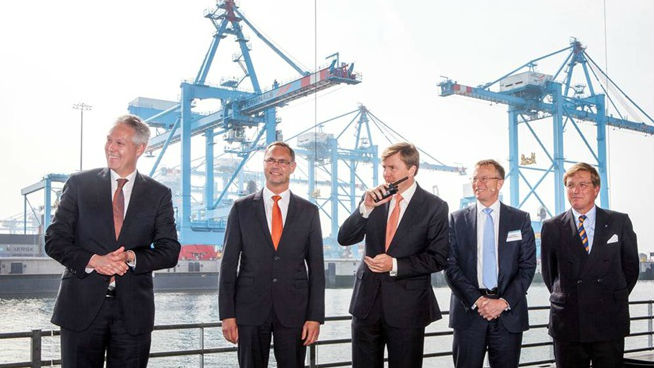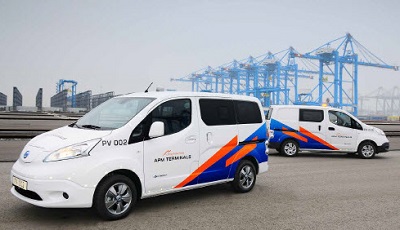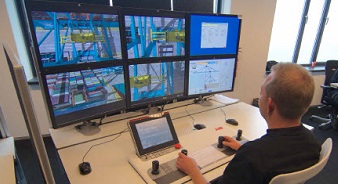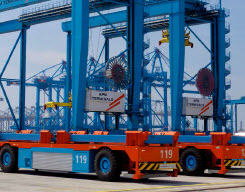APM Opens Most Advanced Container Terminal

APM Terminals has officially opened its new Maasvlakte II Rotterdam facility, the world’s most technologically advanced and environmentally sustainable container terminal, claims the operator.
APM Terminals CEO Kim Fejfer said: “We are honored to officially dedicate our new terminal with you today. APM Terminals Maasvlakte II is clearly a game-changer port in the shipping industry designed to exceed our customers’ expectations. It is significantly safer for our people and all users of the port.
 “It runs on a zero emissions, sustainable business model using renewable energy, benefitting the people of Rotterdam and Europe. And, equally important, our shipping line customers will experience 40 percent higher productivity – thanks to automation.”
“It runs on a zero emissions, sustainable business model using renewable energy, benefitting the people of Rotterdam and Europe. And, equally important, our shipping line customers will experience 40 percent higher productivity – thanks to automation.”
The facility launches the world’s first container terminal to utilize remotely-controlled STS gantry cranes. The cranes move containers between vessels and the landside fleet of 62 battery-powered Lift-Automated Guided Vehicles (Lift-AGVs) which transport containers between the quay and the container yard, including barge and on-dock rail facilities. The Lift-AGV’s also represent the world’s first series of AGV’s that can actually lift and stack a container.
A fleet of 54 Automated Rail-Mounted Gantry Cranes (ARMGs) then positions containers in the yard in a high-density stacking system. The terminal’s power requirements are provided by wind-generated electricity, enabling terminal operations, which produce no CO2, emissions or pollutants, and which are also considerably quieter than conventional diesel-powered facilities.
The facility, constructed on land entirely reclaimed from the North Sea, has been designed as a multi-modal hub to reduce truck traffic in favor of barge and rail connections to inland locations. Construction began in May 2012, with the first commercial vessel call in December 2014.
 Successful systems testing and ramp-up have been completed to bring the first phase of APM Terminals Maasvlakte II into full operational status. The 86 hectare (212 acre) deep-water terminal features 1,000 meters of quay, on-dock rail, and eight fully-automated electric-powered Ship-to-Shore (STS) cranes, with an annual throughput capacity of 2.7 million TEUs, representing an APM Terminals investment of EUR 500 million.
Successful systems testing and ramp-up have been completed to bring the first phase of APM Terminals Maasvlakte II into full operational status. The 86 hectare (212 acre) deep-water terminal features 1,000 meters of quay, on-dock rail, and eight fully-automated electric-powered Ship-to-Shore (STS) cranes, with an annual throughput capacity of 2.7 million TEUs, representing an APM Terminals investment of EUR 500 million.
At planned full build-out, the terminal will cover 180 hectares (445 acres) and offer 2,800 meters of deep-sea quay (19.65 meters/64.5 feet depth), with an annual throughput capacity of 4.5 million TEUs.
“The future of terminal operations is safer, high-volume, high-productivity performance” said Fejfer. “We are pleased to welcome that future here today.”
The existing APM Terminals Maasvlakte I Rotterdam container terminal, which will remain in service, handled 2.46 million TEUs in 2014, and was cited by an independent Journal of Commerce industry study as the most productive container terminal in Europe for the first half of 2014 with 102 crane moves per hour.
ARMGs
APM Terminals Rotterdam Maasvlakte II uses 54 Automated Rail Mounted Gantry (ARMG) Cranes and two rail cranes.
 Maasvlakte II’s innovative design is based upon using ship-to-shore (STS) cranes to unload containers from vessels and place them directly on the Lift AGVs, which can carry two containers at a time, and automatically bring them from the quay to the container yard using an onboard navigation system following a computerized transponder grid.
Maasvlakte II’s innovative design is based upon using ship-to-shore (STS) cranes to unload containers from vessels and place them directly on the Lift AGVs, which can carry two containers at a time, and automatically bring them from the quay to the container yard using an onboard navigation system following a computerized transponder grid.
Once the Lift AGV arrives at its programmed destination, it places the containers into a series of storage racks. The ARMG then arrives to move the container from the rack to its next designated location: the rail terminal, a waiting truck or another area of the storage yard.
The ARMGs use a fully automated system to safely load/unload a container onto a truck chassis. When not operating in support of vessel loading or unloading, the system features a “grooming” capability that re-stows/restacks containers for easy access for the next vessel load plan. This feature of automated yard optimization of the container yard during quiet times allows for better efficiency at peak times.
Lift-AGVs
APM Terminals placed an order for 62 Battery-powered Lift-AGVs, 87 battery packs and two, robotic Battery Exchange Stations, enabling an automated exchange of the battery pack.
In principle, the Battery Lift-AGV is quite similar to the traditional diesel-electric Lift-AGV.
In both types the drive system is electric, but the difference lies in the power source. With the dieselelectric Lift-AGV, a diesel engine generates power. With the Battery Lift-AGV, the energy is supplied by a battery pack.
 The Battery Lift-AGV allows APM Terminals to achieve higher levels of performance while minimizing environmental impact. With diesel-electric Lift-AGVs, the diesel engine produces CO2/NOx/particulate emissions at the terminal. By removing the diesel engines, APM Terminals has removed all local emissions (CO2 / NOx / particulate matter) at the terminal, as well as eliminating diesel engine noise.
The Battery Lift-AGV allows APM Terminals to achieve higher levels of performance while minimizing environmental impact. With diesel-electric Lift-AGVs, the diesel engine produces CO2/NOx/particulate emissions at the terminal. By removing the diesel engines, APM Terminals has removed all local emissions (CO2 / NOx / particulate matter) at the terminal, as well as eliminating diesel engine noise.
The Lift-AGVs use a battery pack that allows eight hours of driving time. To switch battery packs, the Lift-AGVs drive to the Battery Exchange Station and begin a fully automated process in which the Battery Exchange Station completes the procedure through robotic automation.
